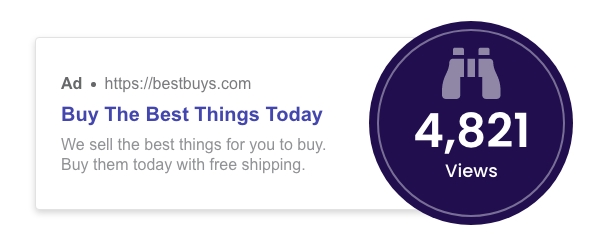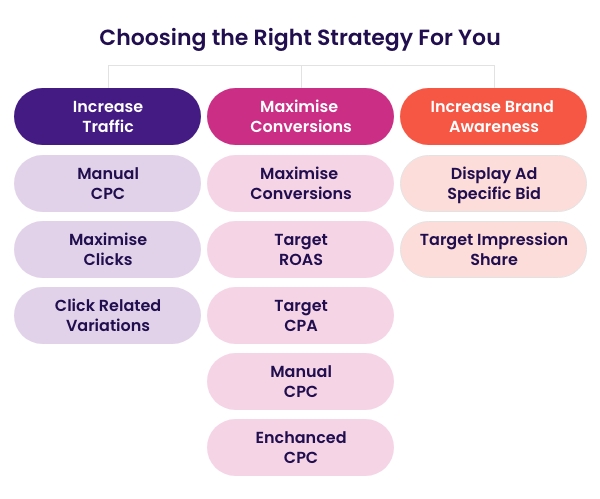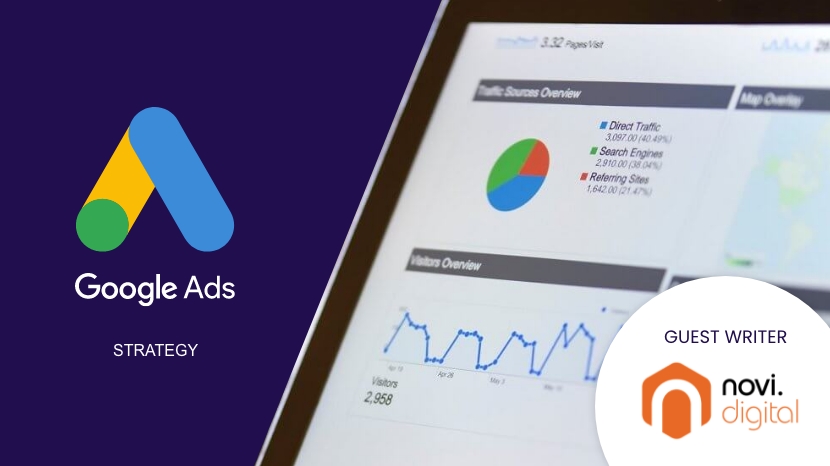When using Google Ads , you need to keep the overall costs down while maximising returns on ad spend as you attain your set objectives. This requires picking the right strategy. There are many strategies, which can confuse you and distract you from your objectives if you are not careful. This article helps you identify the most effective bidding strategy for your Google Ads campaign, to make the most of the process.
What is a bidding strategy?
A bidding strategy is the selection and implementation of a bidding process to set bids for your ads while factoring in the likelihood of that ad to gain you a click or conversion. Considering the number of bidding strategies available, you need to be specific about which ones to implement, depending on what you’re selling.
How are the different types of Google Ads bidding strategies applicable?
Target CPA
Target cost per acquisition is a bidding strategy aimed at optimising conversions. The strategy sets a specific acquisition cost and tries to get as many conversions as possible. Cost per acquisition is the amount of money you’ll spend to acquire one customer.
Therefore, this strategy is best when your primary aim is getting conversions. Target CPA uses conversion tracking data to filter out unprofitable clicks, thus improving the cost versus acquisition ratio. However, you can’t set a maximum cost-per-click bid cap when using this strategy. Additionally, you need a large budget to implement this strategy.
Maximise clicks
This Google Ads strategy aims to get you as many clicks as your set budget can allow. This strategy works best when you enjoy a strong conversion performance and wish to increase the value obtained from the same budget. This simple-to-apply strategy minimises cost per click and maximises search impression shares. Therefore, it is the most efficient strategy for getting you the most traffic. However, it doesn’t guarantee conversions from all that traffic, and the traffic may not be of the highest quality.

Maximise conversions
This Google Ads strategy works to get you the most conversions within your set budget. This strategy identifies individuals likely to convert and focuses more resources on them to get that conversion. The downside is such focus may prove costlier than your set daily budget, thus requiring more funding. Therefore, your bidding approach may prove too costly to sustain.
Target ROAS
The target return on ad spend strategy works reversely, where you determine what returns on your ad spend investment you wish to realise. Therefore, the strategy will deploy resources to ensure you hit that target for the set budget. Your ads will appear before customers most likely to buy and simplify the advertising process if you have many products to sell. However, this somewhat conservative approach may minimise cost per acquisition, thus limiting ad impact. Additionally, the returns-focused approach may limit your chances of netting high-value customers.
Maximise conversion value
This strategy identifies the most optimal cost-per-click bid in an auction by relying on data from a maximise conversions approach. Therefore, you end up with the most value you can get from your ads, with Google prioritising access to individuals who are likely to spend even more.
Manual CPC
The manual cost-per-click strategy is where you set bids at the ad group or keyword level. You’ll retain most of the control over the bidding process but must contend with most of the work in monitoring and adjusting costs. The strategy is suitable for new advertisers or in the initial stages of an ad campaign, as it gives you a deeper understanding of the process. However, you won’t receive the detailed reports associated with automatic bidding, and you’ll miss out on the capabilities of Google’s machine learning algorithms that better identify individuals most likely to convert.
Target impression share
The target impression share strategy automatically sets bids to enable you to reach your impression share goals in your ad campaigns. You can set a maximum CPC bid limit in this strategy, allowing for efficient budget control. Target impression share is great for maximising exposure through your keywords and accurately positioning your search impression share. However, this costly strategy does not necessarily net you the most conversions.

Viewable CPM
The viewable cost per mille or cost for 1,000 views is associated with display ads. The strategy sets target bids for every 1,000 impressions where your display ad was said to have been viewed. Such viewing is not merely a glance but enough of the ad to have made a meaningful impression. This strategy effectively raises brand awareness and manages your ad campaign budget. However, you’ll experience low ROI on low-traffic sites, and you’re not assured of conversions.
Maximum CPM
The maximum CPM strategy is great for raising brand awareness, where you set the highest bid you’ll pay for a video view, with a view being either 30 seconds into the display ad or a full view if the ad is shorter than 30 seconds. Whenever a person interacts with your ad, such as engaging your CTA, you’ll be charged the set bid price. Therefore, this strategy is efficient since you only pay for actual engagement, attracts only interested people, and keep your overall costs minimal. However, the generated attention may not necessarily end up in sales, and it rarely works for ads longer than 10 seconds.
Enhanced CPC
The enhanced cost-per-click strategy is an automated version of the manual CPC strategy, where you utilise Google’s algorithms and other resources. This way, you’ll take the guesswork out of most decisions as Google is more proficient at those than a beginner. However, you may incur higher CPC, which could exceed your budget.
Portfolio bid strategy
A portfolio bid strategy is where you formulate one bid strategy and apply it across all your ad campaigns instead of running different ones per campaign. This approach allows you to set a maximum CPC, even for strategy options that otherwise lack that option. There is also better data sharing among the strategies, making this an easy-to-implement option. However, the bundled strategies need to have the same target CPA for a portfolio bid strategy to be effective.
How do I choose a Google Ads bidding strategy for my needs?
Choosing the right bidding strategy comes down to your ad campaign objectives:
If you wish to increase website traffic for more than earning conversions, you need to choose strategies like manual CPC, maximise clicks, or any other click-related variation.
To maximise conversions, you can rely on any of the strategies in the initial stages. For better results, focus on the maximised conversions, target ROAS, target CPA, manual CPC, and enhanced CPC strategies.
To increase brand awareness, choose strategies that prioritise impression generation. These include all the display ad-specific bid strategies and target impression share strategies.

Conclusion
Google Ads presents one of the most effective online advertising solutions through its bidding approach. To effectively tap into this resource, you need to adopt the right budding strategy. This article highlights the key features of each strategy and shares tips to guide you in the selection process. To maximise the campaign’s effectiveness, you need to consult with the right professions. We understand what you need and will tailor the right solution. Get in touch with us today to find out more.




